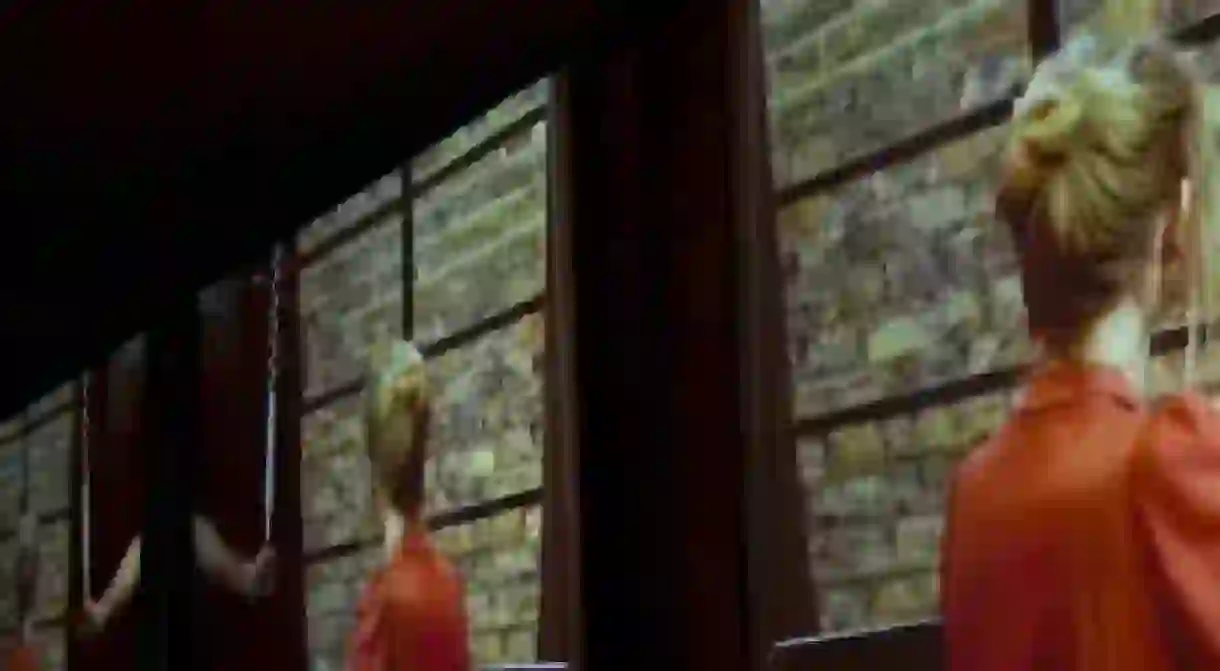Twin Artists Create Beauty From Brutal Histories: Jane And Louise Wilson

London-based artists and twin sisters Jane and Louise Wilson expose the fates of discarded buildings of oppressive institutions like Nazi Germany and the Chernobyl Nuclear Power Plant through their stark, architectural photography and haunting video installations. The sisters bring humanity and emotion back into these inaccessible, lifeless spaces through their artwork.

In a dim, echoing room, a large screen flashes through scenes of a city of deserted ruins – the barbed wire fence around a nuclear waste site, the ominous clicks of a Geiger counter, a curiously placed measuring stick. The scenes of past and present intertwine to tell the story of Chernobyl in the film The Toxic Camera (2012) by Jane and Louise Wilson, twin sisters and English artists. The film was just one part of the 2012 exhibit in Manchester, exploring the ghostly ruins of the nuclear disaster in Chernobyl and Pripyat, a nearby town built for Chernobyl workers, which was subsequently abandoned after the nuclear explosion. Other portions of the exhibit include a photographic series, Atomgrad (Nature Abhors a Vacuum), featuring images of the modern dystopian town Pripyat, and a black cast of a camera that sits alone on a pedestal.
The camera is a replica of the one used by Ukrainian filmmaker Vladimir Shevchenko, who ventured into the aftermath of the 1986 explosion of Chernobyl’s Nuclear Reactor Unit 4 just three days after it occurred and captured the destruction on film. His film Chernobyl: A Chronicle of Difficult Weeks also played at the Wilsons’ exhibit. The original camera became dangerously radioactive and had to be buried, and Shevchenko died shortly after he returned from Chernobyl because of the radiation exposure.
For more than 20 years, Jane and Louise have been working together to create exhibits that embody the menacing and mysterious pasts of these institutional spaces of concentrated power. Born in 1967 in Newcastle upon Tyne, the majority of their artwork focuses on hidden, secretive spaces, a theme which stems from the political climate they grew up in — the Cold War era, explorations in nuclear power, and increased surveillance.

The twins’ tendency to use abandoned architectural spaces to show the haunting, oppressive power of their subjects, however, did not come until later in their careers, but their university-era work carried hints of the same understated, disturbing quality. For example, included in this body of work are identical photographs called Garage (1989) — a black and white scene where the two were murdering each other.
After they both obtained their masters’ in Fine Arts from Goldsmith’s College, London, Jane and Louise lived and worked together in a flat at King’s Cross where they created films inspired by, and featuring the seedy living spaces around them. It was during a residency in Berlin, however, where their work first developed a focus on documenting destructive political power. Their film installation Stasi City (1997) explored the former headquarters of the East German secret police by uncovering the dilapidated shells of the former institutions of power.
Jane and Louise were nominated for the Turner Prize for their exhibition, Gamma (1999), a film installation uncovering the decommissioned former U.S. military base at Greenham Common in Berkshire. The U.S. used the site to house nuclear missiles during the Cold War, and women who were against the British base holding American nuclear weapons held a large protest in the 1980s.

Another exhibition, False Positives and False Negatives, a film called Face Scripting: What Did the Building See? (2011) explores the mystery surrounding the 2010 assassination of a Hamas operative in a Dubai hotel room. The film was made by combining real CCTV footage with the Wilsons’ own film from the hotel room. The exhibit also displays a series of photographs featuring both sisters with geometric shapes painted on their faces. This technique, called ‘dazzle camouflage’, renders faces unrecognizable to surveillance cameras.
Their most recent exhibit, Undead Sun (2014), was a tribute to the centenary of the First World War. The film installation was commissioned for the Imperial War Museum in London. The film explores perspective and deception through propaganda, aerial warfare, and camouflage. Jane and Louise recreated scenes from the war museum’s archives against the backdrop of a huge wind tunnel. The last scene of the film shows a man taking off his uniform and hanging it on barbed wire before walking away completely naked in a solemn act of rebellion against war.
Although an interview shows the sisters rejecting the idea that their artwork is activism, their politically charged subjects are naturally thought provoking, and they challenge us to consider our place in the midst of their displays of modern destruction.













